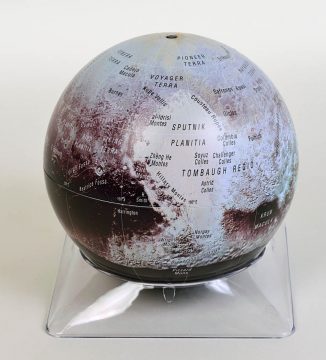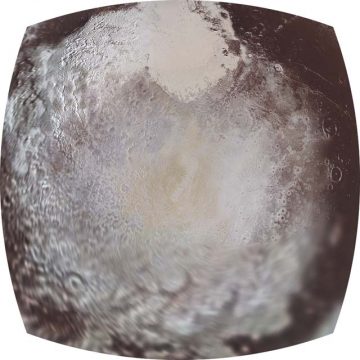Astronomy - Sky & Telescope’s Pluto Globe is Here!
This beautifully detailed 6-inch globe lets you explore the amazing geology revealed by New Horizons during its historic 2015 flyby.

Sky & Telescope's Pluto globe is 6 inches (15 cm) across and shows the informal names of 60 craters and other features. It comes with a clear plastic base and an information card with details about the globe and key facts about Pluto.
Sky & Telescope / Sean Walker
Sky & Telescope / Sean Walker
The editors of Sky & Telescope are proud to announce the arrival of the latest addition to our extensive line of planetary globes. After a year-long production effort, we received our first Pluto globes this week.
Now you can have one too!
Click here for the order page.
Click here for the order page.
We first kicked around the idea of creating a Pluto globe within days of New Horizons' historic flyby of this frigid world in July 2015. Before the spacecraft got there, no one was sure how much detail might be seen on that icy surface. Of course, everyone was astounded by how interesting Pluto has turned out to be (some of the great images are here and here), and the planning for our globe began.
Unfortunately, the spacecraft couldn't capture all of Pluto with the same fidelity, and about a quarter of its surface (everything southward of latitude –30°) remained in shadow throughout the flyby. So we decided early on that our usual 12-inch globe format was a poor "fit" to the available data — it would just be too big. (Anyone who's ever seen an over-magnified telescopic view of Mars or Jupiter knows exactly what I mean!)
Also, we wanted as many people as possible to be able to explore Pluto's fascinating details firsthand, and switching to a 6-inch (15-cm) diameter made the final product much more affordable.
Details, Details
To make this globe a reality, about a year ago I started working with the New Horizons science team — notably principal investigator Alan Stern (Southwest Research Institute), Ross Beyer (NASA Ames Research Center), and Paul Schenk (Lunar & Planetary Institute). First we needed a detailed, full-color mosaic — and that took time because the flyby images were coming to Earth in a trickle that lasted for many months. Then S&T Illustration Director Gregg Dinderman worked with Kevin Dzurny and Dell Torgerson at Replogle Globes to make sure all those beautiful details would make it onto the finished product.

Here's the raw material for S&T's Pluto globe: a mosaic of the dwarf planet's northern hemisphere, specially projected into polar coordinates.
NASA
NASA
Then there was the matter of feature names. All of them remain unofficial, because the New Horizons team and officials from the International Astronomical Union have only recently begun a series of meetings to hammer out what we'll ultimately call the peaks, valleys, and uniquely quirky features on Pluto's surface.
In the end we used a mosaic of more than 125 images acquired by the spacecraft during the 7 days prior to and during its close flyby on July 14, 2015. The resulting base map shows details as small as 1 mile (1½ km) across, and we included the informal names of 60 craters and other features.
We added a freestanding base, manufactured specifically for this project, so that you can pick up the globe and examine its details closely. We also include a 4-by-6-inch card that includes information about how the globe was made, key facts about Pluto, and a guide to the Latinized names used by the IAU to identify specific feature types.
We're very proud and happy with the result, and I hope you'll consider getting one of these for yourself or for some Pluto-lover in your life. Although Alan Stern is already lobbying NASA to build a Pluto orbiter, chances are this is the best view of Clyde Tombaugh's remarkable discovery we'll have for decades to come.
No comments:
Post a Comment